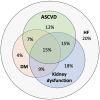Therapeutic Consequences and Prognostic Impact of Multimorbidity in Heart Failure: Time to Act
- PMID: 39797222
- PMCID: PMC11722306
- DOI: 10.3390/jcm14010139
Therapeutic Consequences and Prognostic Impact of Multimorbidity in Heart Failure: Time to Act
Abstract
Background/Objectives: In heart failure (HF) with reduced ejection fraction (HFrEF), the early diagnosis and proper treatment of comorbidities (CMs) are of fundamental relevance. Our aim was to assess the prevalence of CMs among real-world patients requiring hospitalisation for HFrEF and to investigate the effect of CMs on the implementation of guideline-directed medical therapy (GDMT) and on all-cause mortality (ACM). Methods: The data of a consecutive HFrEF patient cohort hospitalised for HF between 2021 and 2024 were analysed retrospectively. Sixteen CMs (6 CV and 10 non-CV) were considered. Patients were divided into three categories: 0-3 vs. 4-6 vs. ≥7 CMs. GDMT at discharge and ACM were compared among CM categories. The predictors of 1-year ACM were also evaluated. Results: From the 388 patients (male: 76%, age: 61 [50-70] years; NT-proBNP: 5286 [2570-9923] pg/mL; ≥2 cardiovascular-kidney-metabolic disease overlap: 46%), a large proportion received GDMT (RASi: 91%; βB: 85%; MRA: 95%; SGLT2i: 59%; triple therapy [TT: RASi+βB+MRA]: 82%; quadruple therapy [QT: TT + SGLT2i]: 54%) at discharge. Multimorbidity was accompanied with a (p < 0.05) lower application ratio of RASi (96% vs. 92% vs. 85%; 0-3 vs. 4-6 vs. ≥7 CMs) and βB therapy (94% vs. 85% vs. 78%), while MRA (99% vs. 94% vs. 94%) and SGTL2i use (61% vs. 59% vs. 57%) did not differ (p > 0.05). Patients with multimorbidity were less likely to be treated with TT (93% vs. 82% vs. 73%, p = 0.001), while no difference was detected in the implementation of QT (56% vs. 54% vs. 50%, p = 0.685). The 1-year ACM of patients with an increased burden of CMs was higher (9% vs. 13% vs. 25%, p = 0.003). The risk of 1-year ACM was favourably affected by the use of TT/QT and less severe left ventricular systolic dysfunction, while having ≥5 CMs had an unfavourable impact on prognosis. Conclusions: According to our real-world analysis, HFrEF patients with an increased burden of CMs can expect a less favourable outcome. However, modern GDMT can even be applied in this patient population, resulting in a significantly improved prognosis. Thus, clinicians should insist on the early, conscious implementation of a prognosis-modifying drug regime in multimorbid HF patients as well.
Keywords: comorbidity; guideline-directed medical therapy; heart failure; multimorbidity; prognosis.
Conflict of interest statement
The authors declare no conflicts of interest.
Figures






Similar articles
-
The Feasibility of a Guideline-Directed Medical Therapy Rapid Up-Titration Programme Among Real-World Heart Failure Patients: A Multicentre Observational Study.J Clin Med. 2025 May 21;14(10):3611. doi: 10.3390/jcm14103611. J Clin Med. 2025. PMID: 40429606 Free PMC article.
-
The Optimization of Guideline-Directed Medical Therapy during Hospitalization among Patients with Heart Failure with Reduced Ejection Fraction in Daily Clinical Practice.Cardiology. 2023;148(1):27-37. doi: 10.1159/000528505. Epub 2022 Dec 5. Cardiology. 2023. PMID: 36470212
-
[The changes in the pharmacotherapy of heart failure with reduced ejection fraction and its effect on prognosis: experience in the Hungarian clinical practice].Orv Hetil. 2024 May 5;165(18):698-710. doi: 10.1556/650.2024.33045. Print 2024 May 5. Orv Hetil. 2024. PMID: 38709594 Hungarian.
-
Initiation and sequencing of guideline-directed medical therapy for heart failure across the ejection fraction spectrum.Heart Fail Rev. 2025 May;30(3):515-523. doi: 10.1007/s10741-025-10481-7. Epub 2025 Jan 15. Heart Fail Rev. 2025. PMID: 39815071 Review.
-
Optimizing Foundational Therapies in Patients With HFrEF: How Do We Translate These Findings Into Clinical Care?JACC Basic Transl Sci. 2022 Mar 2;7(5):504-517. doi: 10.1016/j.jacbts.2021.10.018. eCollection 2022 May. JACC Basic Transl Sci. 2022. PMID: 35663626 Free PMC article. Review.
Cited by
-
Tirzepatide, a dual GIP/GLP1-receptor co-agonist preserves cardiac function and improves survival in angiotensin II-induced heart failure model in mice: comparison to liraglutide.Cardiovasc Diabetol. 2025 Jun 14;24(1):253. doi: 10.1186/s12933-025-02806-5. Cardiovasc Diabetol. 2025. PMID: 40517248 Free PMC article.
-
The Feasibility of a Guideline-Directed Medical Therapy Rapid Up-Titration Programme Among Real-World Heart Failure Patients: A Multicentre Observational Study.J Clin Med. 2025 May 21;14(10):3611. doi: 10.3390/jcm14103611. J Clin Med. 2025. PMID: 40429606 Free PMC article.
References
-
- Bhatt A.S., Ambrosy A.P., Dunning A., DeVore A.D., Butler J., Reed S., Voors A., Starling R., Armstrong P.W., Ezekowitz J.A., et al. The burden of non-cardiac comorbidities and association with clinical outcomes in an acute heart failure trial—Insights from ASCEND-HF. Eur. J. Heart Fail. 2020;22:1022–1031. doi: 10.1002/ejhf.1795. - DOI - PMC - PubMed
-
- Tomasoni D., Vitale C., Guidetti F., Benson L., Braunschweig F., Dahlström U., Melin M., Rosano G.M.C., Lund L.H., Metra M., et al. The role of multimorbidity in patients with heart failure across the left ventricular ejection fraction spectrum: Data from the Swedish Heart Failure Registry. Eur. J. Heart Fail. 2024;26:854–868. doi: 10.1002/ejhf.3112. - DOI - PubMed
-
- Conrad N., Judge A., Tran J., Mohseni H., Hedgecott D., Crespillo A.P., Allison M., Hemingway H., Cleland J.G., McMurray J.J.V., et al. Temporal trends and patterns in heart failure incidence: A population-based study of 4 million individuals. Lancet. 2018;391:572–580. doi: 10.1016/S0140-6736(17)32520-5. - DOI - PMC - PubMed
LinkOut - more resources
Full Text Sources
Research Materials
Miscellaneous

